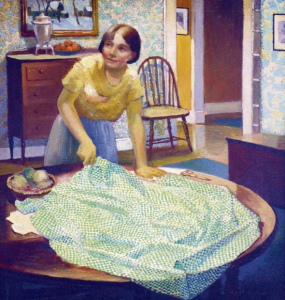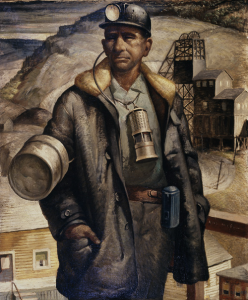Biography
Roy Lowell Hilton was born in Boston, MA in 1891. He grew up in Winchester, MA and attended the Phillips Academy in Andover, MA, graduating in 1911. He subsequently studied art at the Eric Pape School of Art and at the Fenway School in Boston, after which he worked as a freelance illustrator.
In 1928 Hilton moved to Pittsburgh, where he got a job teaching night classes in the Department of Painting and Decoration at the Carnegie Institute of Technology. He married Helen Anna Dieter in 1929. The next year he was promoted to an Instructor in Design at Carnegie Institute of Technology, where he remained on the faculty for nearly 30 years.
In the 1930s Hilton's art was exhibited at the Carnegie International in Pittsburgh (1933, 1935), in "Painting and Sculpture from 16 American Cities" at the Museum of Modern Art in New York (1933), in the "Painting and Sculpture from 16 American Cities" at the Whitney Museum of Modern Art in New York (1934) and at the Corcoran Gallery in Washington, DC.
Hilton received commissions for Post Office murals in two cities: "Life in Rocky Mount" for Rocky Mount, VA; and "The New Stagecoach" and "Building of Westfield" for Westfield, NJ. "Building of Westfield" was destroyed during lobby renovations, but the other murals remain on display in their original locations.
Hilton's painting career continued into the 1940s. His painting of Forbes Field in Pittsburgh was on the cover of the Saturday Evening Post in 1940. His work was included in the "Artists for Victory" show at the Metropolitan Museum of Art in New York (1942), and he had a solo show at the Carnegie Museum of Art in Pittsburgh in 1943. The Carnegie International "Painting in the United States 1947" also included work by Hilton, and he received the Anonymous Prize of the Associated Artists of Pittsburgh in 1951.
In 1945 Hilton's drawing class included the freshman Andy Warhol. Warhol had troubles with perspective drawing, for which Hilton was a master. As a result the phrase "If it's tiltin', see Hilton" was bandied about by his classmates. In 1958 Hilton was still teaching part-time at Carnegie Tech. He died in Pittsburgh in 1963.


Critical Analysis
Hilton's Post Office murals show a contrast in their compositions. His "Life in Rocky Mount" consists of three panels, with an agricultural scene in the center, flanked by people working at machines on each side. "The New Stagecoach" is much busier, with a crowd of people around the town's new stagecoach. Both murals share several qualities with Hilton's easel paintings. They display expert draftsmanship - and, if course, flawless perspective. Hilton used color subtly and sparingly. His paintings always have rather muted tones. While Hilton's work wasn't particularly adventurous, it was very well executed, and a painting like "The Miner" remains as classic of its era.
Murals
- Westfield, New Jersey - Post Office: The New Stagecoach
- Rocky Mount, Virginia - Post Office: Life in Rocky Mount
References
- Wendy G, Another American gem: Roy Hilton, Travels With My Art August 12 (2023).
- Biography of Roy Hilton (1891-1963) (artprice).
- Patricia Lowry, Painting alludes to Pittsburgh's working class, Pittsburgh Post-Gazette December 25 (2010).
- Roy Hilton (askART).
- Roy Hilton (The Westmoreland Museum of American Art).
- Roy Hilton Art for Sale and Sold Prices (invaluable).
- Roy Lowell Hilton (Family Search).
- Bennard B. Perlman, When Warhol Nearly Flunked Out of Art School, The Baltimore Sun May 6 (1994).